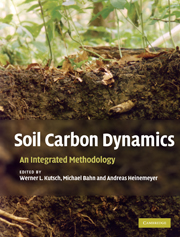Book contents
- Frontmatter
- Contents
- List of Contributors
- Preface
- Editorial Acknowledgements
- 1 Soil carbon relations: an overview
- 2 Field measurements of soil respiration: principles and constraints, potentials and limitations of different methods
- 3 Experimental design: scaling up in time and space, and its statistical considerations
- 4 Determination of soil carbon stocks and changes
- 5 Litter decomposition: concepts, methods and future perspectives
- 6 Characterization of soil organic matter
- 7 Respiration from roots and the mycorrhizosphere
- 8 Separating autotrophic and heterotrophic components of soil respiration: lessons learned from trenching and related root-exclusion experiments
- 9 Measuring soil microbial parameters relevant for soil carbon fluxes
- 10 Trophic interactions and their implications for soil carbon fluxes
- 11 Semi-empirical modelling of the response of soil respiration to environmental factors in laboratory and field conditions
- 12 Modelling soil carbon dynamics
- 13 The role of soils in the Kyoto Protocol
- 14 Synthesis: emerging issues and challenges for an integrated understanding of soil carbon fluxes
- 15 Appendix: Towards a standardized protocol for the measurement of soil CO2 efflux
- Index
- References
1 - Soil carbon relations: an overview
Published online by Cambridge University Press: 11 May 2010
- Frontmatter
- Contents
- List of Contributors
- Preface
- Editorial Acknowledgements
- 1 Soil carbon relations: an overview
- 2 Field measurements of soil respiration: principles and constraints, potentials and limitations of different methods
- 3 Experimental design: scaling up in time and space, and its statistical considerations
- 4 Determination of soil carbon stocks and changes
- 5 Litter decomposition: concepts, methods and future perspectives
- 6 Characterization of soil organic matter
- 7 Respiration from roots and the mycorrhizosphere
- 8 Separating autotrophic and heterotrophic components of soil respiration: lessons learned from trenching and related root-exclusion experiments
- 9 Measuring soil microbial parameters relevant for soil carbon fluxes
- 10 Trophic interactions and their implications for soil carbon fluxes
- 11 Semi-empirical modelling of the response of soil respiration to environmental factors in laboratory and field conditions
- 12 Modelling soil carbon dynamics
- 13 The role of soils in the Kyoto Protocol
- 14 Synthesis: emerging issues and challenges for an integrated understanding of soil carbon fluxes
- 15 Appendix: Towards a standardized protocol for the measurement of soil CO2 efflux
- Index
- References
Summary
INTRODUCTION
Soils are localized between base rock, atmosphere and vegetation, and represent a home for numerous organisms and the place of countless biogeochemical transformation and transfer processes. In addition, soils store many substances that are essential to maintain human life and ecosystem processes. Therefore, soils have been a research focus for more than a century and soil science has deep connections to ecology, agriculture and nature conservation.
The most important practical applications of soil science are diagnostics and maintenance of soil fertility and, more recently, definition of the role of soils in the terrestrial carbon balance in the context of increasing atmospheric CO2 concentration and the resulting greenhouse effect. Carbon stored in soils represents the largest carbon pool in nearly all terrestrial biomes (Bolin et al., 2001) and thus it has a huge potential for either sequestering or releasing carbon into the atmosphere. Consequently, knowledge of the dynamics of soil carbon is essential for a better understanding of the terrestrial carbon balance. However, inter-annual changes in soil carbon stocks are small compared to the total carbon stored in soils, and thus determining any changes in soil carbon stocks by repeated inventories is difficult. On the other hand, flux measurements also bear inaccuracies and uncertainties, confounding attempts to directly measure and model the CO2 flux from the soil and linking this flux to the underlying processes. There are considerable challenges in monitoring soil fluxes without disturbing the plant–soil carbon flow.
- Type
- Chapter
- Information
- Soil Carbon DynamicsAn Integrated Methodology, pp. 1 - 15Publisher: Cambridge University PressPrint publication year: 2010
References
- 3
- Cited by

